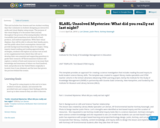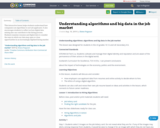
This hyperdoc lesson will allow your students to work together to building a classroom community specifically in Google Classroom. Enjoy!
- Subject:
- Educational Technology
- Material Type:
- Lesson Plan
- Author:
- Jen Van Fleet
- Date Added:
- 03/24/2017

This hyperdoc lesson will allow your students to work together to building a classroom community specifically in Google Classroom. Enjoy!

Introduction How often do you use a Word Processor? Have you any idea how easy it is to create a table of contents? Or how easily you may change all the headings of your text from Times New Roman 14 to Arial 12? Well very easy, no matter if you have to deal with a document of 20 or 200 pages. Here you will find some tips and guidelines on handling large documents with LibreOffice Writer. Note that this module is referred to users who have used before a Word Processor.

This unit includes four lessons and two student working days that culminate in students designing an interactive audio and visual display using emaze. The purpose of this visual display is to document their journey throughout the process of becoming familiar with the traceability (and sometimes lack thereof) of beef, produce, and seafood regulations. With their visual displays, they will be able to educate their family, peers, and the public about food consumption choices and provide background knowledge about its origins.
Using inquiry-based reading and reading apprenticeship strategies, students will explore an anchor text as well as two supplemental texts which they will use to develop their own essential and supporting questions to guide their research. AP Environmental students will explore a variety of texts and resources to increase their knowledge and awareness of where our food (seafood, beef, and produce) in the United States originally is located, how it was obtained, and the laws that govern the process behind the scenes.

This interactive lesson helps students understand how companies use algorithms to sort job applicants. It also encourages students to reflect on how digital data mining also can contribute to the hiring process. Students examine resumes and digital data to consider the ways in which our data may open or close opportunities in an increasingly digitized hiring market.

SummaryStudents will learn more about hacking and trolling in the online world. They will collaborate and build off others ideas and practice how to respond thoughtfully when creating discussions/posts/ comments. AccommodationsThis activity needs prior background that includes discussions about real news/fake news, what hacking truly means, and acting positive online, and digital literacy. This lesson allows for accommodations to be met through videos (close captioning) and completing commenting (recording it, using images/symbols). Articles/videos can be done together or independently. Images or symbols could be added to enhance learning (http://www.rcsthinkfromthemiddle.com/csi-color-symbol-image.html) Grade Level This lesson is for 5th grade and can be adjusted for younger or older students. Time duration Estimated time: One hour (or over 2 days). Teachers chose if they want to extend this activity. Teachers can divide students into groups & assign one article/video, allow them to decide, or do all based upon preference.Materials neededAccess to computers/tablets (earbuds/headphones) & google drive or other LMS systemPadlet link https://padlet.com/whitmanh1/fjp8ipdt8t6o--create separate padlets (copy/duplicate it) for multiple classesPrint an article or 2 in case the internet acts up, discussion questions posted at each table, examples of comments/responses that show 3 levels (target-exceeds, acceptable-meets, unacceptable- beginning/progressing) and rubric for self assessmentSchedule of Activities & decide on partner work (Table one does assignment #1, table two does #2, table three and four do #3, Table five does #4)